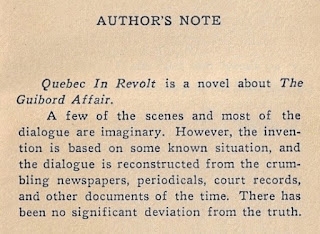
So Long at the Fair
Janet Gregory Vermandel
New York: Dodd, Mead, 1968
186 pages
Canadian publishers really messed up with Expo 67; McClelland & Stewart, Macmillan, Ryerson, and Copp Clarke published nothing related to the fair. Swan, so small a paperback house that it is pretty much forgotten today, sought to cash in with Instant French, its penultimate title.
Canadian publishers really messed up with Expo 67; McClelland & Stewart, Macmillan, Ryerson, and Copp Clarke published nothing related to the fair. Swan, so small a paperback house that it is pretty much forgotten today, sought to cash in with Instant French, its penultimate title.
Meanwhile, newspapers, magazines, and news agents seized the opportunity by publishing guides to the fair. MacLean-Hunter's official guide is by far the most common, followed by Bill Bantey's Expo 67, published by the Montreal Gazette.
American book publishers were far more savvy, giving us a memoir (Expo Summer), a work of pornography (Sexpo '69), and this novel of suspense.
So Long at the Fair was Janet Gregory Vermandel's debut. She shares something with memoirist Eileen Fitzgerald and pornographer Charles E. Fritch in being American. That she actually lived in Montreal sets her apart. The publisher's author bio (right) is one of the most unusual I've ever read.
I like it.
I like it.
Vermande would go on to write five more novels, most of which were set in Montreal. She eventually returned to the United States and her home town of Buffalo, dying in 2002 at age 79, another victim of Alzheimer's.
The first sentence of So Long at the Fair shook me cold:
Why Montreal?
Lisa preferred Paris or New York, but her mother did not approve. Montreal was a neat compromise. Mrs Bentham insists that her daughter room with Victoria Lester, niece to a bridge partner, until she finds her footing. And so, Lisa's journey from Buffalo to Montreal ends with a walk through a polished marble lobby lit by crystal chandeliers.
Victoria's apartment is luxurious and spacious – more than enough room for a guest – which is surprising for a woman who does occasional work at a temp agency. She and Lisa have known each other since childhood, but were never quite friends. After some awkwardness, they spend the evening catching up. The next morning Victoria heads off to work, leaving her guest alone to explore a foreign city.
"Good-by, Brian."Brian is narrator Lisa Bentham's ex-fiancé. They'd worked together at a Buffalo advertising agency until office gossip of his affair with a lithe, blonde co-worker reached her ears. Seems everyone knew but her. So Long at the Fair begins with Lisa, all of twenty-two, flying off to Montreal for a fresh start.
Why Montreal?
Lisa preferred Paris or New York, but her mother did not approve. Montreal was a neat compromise. Mrs Bentham insists that her daughter room with Victoria Lester, niece to a bridge partner, until she finds her footing. And so, Lisa's journey from Buffalo to Montreal ends with a walk through a polished marble lobby lit by crystal chandeliers.
Victoria's apartment is luxurious and spacious – more than enough room for a guest – which is surprising for a woman who does occasional work at a temp agency. She and Lisa have known each other since childhood, but were never quite friends. After some awkwardness, they spend the evening catching up. The next morning Victoria heads off to work, leaving her guest alone to explore a foreign city.
Lisa returns in late afternoon to an empty apartment, waits for Victoria, gives up, makes herself an omelette, and then turns in. She's awoken after midnight by the sound of someone moving about the apartment. When she calls out Victoria's name all goes quiet.
It's not her.
It's not her.
Lisa next sees Victoria at the city morgue.
Maybe New York wasn't such a bad idea, Mrs Bentham.
So Long at the Fair features two murders, an attempted murder, an assault, break-ins, extortion, and various other crimes committed by seven different characters, not all of whom are connected – and yet, Montreal comes off rather well. Vermandel, clearly loved her adopted city, and has her heroine share the love by treating her to evenings out at Altitude 737, La Bonne Femme, and La Reserve in the Windsor Hotel. The Buffalo gal makes her way with surprising ease. Jobs are plentiful. The afternoon Lisa quits her first job, with printer Ross-Fairchild, she's hired as a secretary at the Expo 67 Administration and News Pavilion.
Publisher Dodd, Mead positioned So Long at the Fair as a "story of murder and romance, set against the fabulous background of Montreal's Expo '67." Certainly "background" – as opposed to "backdrop" – was intentional. The novel takes place in January 1967, ending with the fair still three months away. Set during the planning of Expo, it's to Vermandel's credit that she captures something of the excitement that until now I'd read about only in old newspaper and magazines.
Leave it to an American expat.
Leave it to an American expat.
Trivia: As "Murder at Expo 67," a condensed version appeared in the October 1967 issue of Cosmopolitan (the subject of next week's post).
Object: A typical Red Badge Mystery in that it is a cheaply produced hardcover. In this case, the boards are blue. The jacket is by Alan Peckolick, best-known for the GM logo.
I purchased my copy earlier this year from a bookseller located in League City, Texas. Price: US11.75.
Access: A few copies are listed online. At US$7.41, the least expensive is described as being in good condition. Seems a bargain.
I purchased my copy earlier this year from a bookseller located in League City, Texas. Price: US11.75.
Access: A few copies are listed online. At US$7.41, the least expensive is described as being in good condition. Seems a bargain.
The most expensive – £31 – is the UK edition published in 1968 by Herbert Jenkins as Murder Most Fair.
Not sure about the title, but I do prefer its cover to the American.
There has never been a Canadian edition.
There has never been a Canadian edition.
There have been two translations, the earliest being the German Kastanien aus dem Feuer (1968), which was followed by the Dutch Het rode paspoort (1969).
Neither cover depicts a scene found in the novel. Of the two, I like Het rode paspoort more, but only because it imagines a Montreal that has never existed.
Sadly, there has never been a French translation.
What is wrong with us?
Related posts:




































